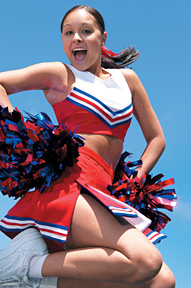Inside Cheerleading: The Most Dangerous Sport for Women
The Risks, the Rigors and the Role of Chiropractic Care
By Brenda Duran
On a warm evening in 2003, Krista Parks was beaming with pride on a football field as a cheerleader at the University of Memphis. This was her moment - her squad was practicing for the national cheer championship in Orlando, Fla.
Parks was to pull off an ambitious stunt - a high front flip in the air from the top of the pyramid, landing in the arms of her squad; instead, she lost her momentum and fell head first onto a 2-inch foam mat on concrete. The result: a broken neck, a blood clot in her brain and multiple fractures.
"I couldn't feel or move anything," Parks recalled. "I was pretty miserable."
Following the incident Parks underwent three surgeries, had to wear a neck brace, and then had to deal with years of physical therapy. A permanent shunt was placed in her spine to help drain fluid from her brain because her body can no longer do it.
Today, she is also dealing with life-altering changes to her cognitive abilities - loss of memory, delayed comprehension and mental fogginess.
 "It's not just throwing around pom poms, it is a real, dangerous athletic activity that comes with risks," said Parks, now executive director for the National Cheer Safety Foundation. "There is a lot that needs to be done to make it safer."
"It's not just throwing around pom poms, it is a real, dangerous athletic activity that comes with risks," said Parks, now executive director for the National Cheer Safety Foundation. "There is a lot that needs to be done to make it safer."
And one of the things that can make it much safer - and healing faster - is consistent chiropractic care, she said.
"Chiropractic care has helped me with pain management, I can sleep better and not have to finish my day in agonizing pain," said Parks, who also works as a physical therapy assistant at Spinal Healthcare Associates in Memphis, Tenn. "It's an approach to pain management I really love."
Since she started chiropractic care for her catastrophic injuries a few years ago, Parks said her pain level has decreased to the point where she can function much better on a daily basis.
The Most Dangerous Female Sport
In a 2009 report, the National Center for Catastrophic Sports Injury (NCCSI) Research at the University of North Carolina at Chapel Hill, N.C., declared cheerleading the "most dangerous female sport in the United States" based on injury data they obtained from 1982-2008 that showed approximately two-thirds of severe school sports injuries over the past 25 years were from cheerleading.
The reason is quite straightforward: At many high schools and colleges, and at the professional level, it is no longer enough for the cheer squad to simply coordinate chants and perform dance routines.

